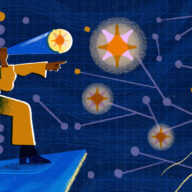When I first entered the workforce, I believed that my work and my life should be kept separate. As the assistant to a marketing executive, my main priority was to be efficient and valuable so I could move up the ladder. I didn’t have time to make friends and didn’t see how they’d be valuable in helping me achieve my goals. Plus, having friends at work could pose a serious risk to my career – it was much easier to battle for that rare promotion opportunity with someone who wasn’t my friend.
The harder I worked, the more time I spent at the office. Before I knew it, I was working 12 or more hours a day. On those late nights, the only other people in the office were the four other executive assistants who all happened to share my same outlook on work friends.
At first, we only talked about scheduling meetings or expense reports. However, the more hours we spent at the office, the lonelier we became. Soon enough, we were ordering take out dinner and working together into the late hours of the evening. And sure enough, in spite of all our best efforts, our work relationships grew into real friendships. The closer we became, the closer our bosses and their teams became. Within two years, all of us were promoted from assistant to marketing managers and we worked on some of our company’s most successful campaigns together.
Building strong work relationships is a challenge
I’ve heard the same story from countless colleagues. Building strong professional relationships is a challenge. It’s something that we don’t learn in school. Many people are able to climb the corporate ladder because of their individual contributions and knowledge, not for their ability to collaborate. But, what does this “go it alone” mindset actually accomplish for us?
In a time when it’s easier than ever to communicate at work via chat, email, phone calls, video calls or a shared document, we still aren’t connecting with each other. According to a study by Harvard Business Review, rates of loneliness have doubled in the United States in the last 50 years. A recent survey by Cigna, a health insurance company, found that nearly half of Americans feel alone (46 percent). In fact, former U.S. surgeon general Vivek Murthy believes we’re experiencing a loneliness epidemic that poses serious public health concerns. Loneliness is just as harmful as smoking 15 cigarettes a day. It’s also associated with a greater incidence of anxiety, depression, heart disease, and dementia.
At work, loneliness is associated with impaired performance, creativity and decision making. “Once you start getting into the cycles of loneliness, you’re in a different psychological state. Eventually, that breeds into more loneliness,” says Hakan Ozcelik of California State University in Sacramento. Ozcelik and his research partner, Dr. Sigal Barsade of UPenn, published a study in which they found that despite lonelier employees’ desire to connect with others, workplace loneliness resulted in the lonely employees becoming less approachable and committed to their organizations.
“There is an inherent link between loneliness and the workplace, with employers in a unique position to be a critical part of the solution,” says Douglas Nemecek, M.D., Chief Medical Officer for Behavioral Health at Cigna. The UK has even appointed a Minister of Loneliness to address the growing epidemic, which costs UK employers up to $3.5 billion annually.
How to develop good relationships at work
With loneliness posing significant health and economic threats to society, what do healthy relationships at work like the ones I forged with my fellow executive assistants do for our overall feelings of connection at work? A recent survey by O.C. Tanner, a company that develops employee recognition and reward strategies, found that 72 percent of employees who have a best friend at work are satisfied with their jobs, compared to 54 percent of those who don’t have a best friend at work.
1. Create a place for emotions to exist
As one of our basic emotions – which include anger, fear, happiness, sadness, guilt, shame, safety, and hurt – loneliness is innate, universal and cannot be prevented.
“If you want to solve loneliness, then what you’re saying is you want to create a place for emotions to exist,” says Julie Barrios, a Leadership Development and Culture Strategist. “But teams don’t have the language to get to know each other.”
Because loneliness is a basic emotion, she recommends spending time building emotional vocabulary as individuals and teams. In the same way that having a large vocabulary makes people more articulate, developing a rich emotional vocabulary helps us identify and handle our emotions more effectively.
“If you want to solve loneliness, then what you’re saying is you want to create a place for emotions to exist.” – Julie BarriosBy spending time to develop a shared emotional vocabulary, Barrios believes you’ll create a “tap in, tap out culture” where team members are aware of the strengths and weaknesses of their teammates and can collaborate more efficiently.
“Companies are operating out of such urgency to get the job done that they’re not taking the time to encourage employees to develop strategic awarenesses of each other. If you make the business decision to take the time to get to know each other, it creates a less lonely culture because people feel supported and interdependent.”
Leaders should also factor an employee’s emotional vocabulary into managerial promotions. “If a person isn’t capable of whole hearted engagement and doesn’t have a robust emotional vocabulary, they shouldn’t be a manager. Instead, there should be a path to promotion as an individual contributor,” says Barrios.
2. Understand your own emotional vocabulary
For each of our basic emotions, try writing down different words that express the emotion’s intensity from mild to medium to extreme. For example, “sadness” can be expressed using the words “blue” (mild), “depressed” (medium), or “devastated” (extreme).
You may hear a colleague say they’re kind of “frustrated” at work. This is pretty normal as work can be frustrating. But what if you were to learn that what they really felt was confusion over the purpose of their quarterly objectives, or that they were conflicted over how to handle a difficult conversation they had with a coworker.
That provides an entirely new understanding of the “frustration” they are feeling. It’s important for managers and colleagues to listen up for those emotional words and really ask questions to understand the deeper meaning behind them.
When you take the time to truly understand what someone is feeling, they in turn feel known and understood, which helps with workplace loneliness.3. Show your appreciation for people
Individuals can reinforce healthy team relationships by providing praise that is regular and specific.
Praise can be about how a colleague successfully handled a project, the way they overcame a road block, something you admire about their work, or how they make you feel.
At Atlassian we encourage individuals to give team members kudos (thank you notes with small gifts) for embodying a specific trait from our company values. All of our employees are encouraged to give someone a kudos in their first 90 days. Even if you don’t have budget for small gifts, a simple thank-you note goes a long way.
4. Develop shared practices around the use of technology
As remote work becomes more popular – more than two-thirds of people around the world work away from the office at least once every week – technology as a means of collaboration is essential. However, it’s important to develop inclusive and strategic technology practices to build a productive, successful, and unlonely team.
“The only problem with technology is that it’s changing behaviors in a way that you might get addicted and it’s not leaving room for natural social interaction,” says Ozcelik. He believes that social media is often used to fill a void that someone feels in their interpersonal interactions, whereas collaboration technology can be incredibly useful in developing bonds on a team.
Chat tools like Slack allow for employees to chat about a team project or a shared interest, like podcasts, sports, or books. However, if a conversation gets heated or important feedback needs to be shared, video technologies like Zoom allow teams around the world to connect realtime if in-person conversation isn’t possible. If your team is in the same office, encourage everyone to close their laptops and put their cell phones away during meetings so everyone can make eye contact and be present with each other.
5. Encourage volunteerism
One in four companies have already identified volunteer time off (VTO) as a valuable strategy for recruiting and maintaining talent, but it also can help diminish loneliness. The Campaign to End Loneliness suggests that people offer time or their skills to others as a means to overcome feeling lonely.
Volunteering has been shown to foster soft skills like collaboration, empathy, adaptability, and leadership, which also support one’s ability to build an emotional vocabulary. If your company doesn’t offer VTO, try providing ways for employees to help plan social events, teach their skills to new hires, or lend their expertise to a side project.
6. Set up systems for success
“The manager’s role is more of a social engineer.” – Hakan Ozcelik“[A manager’s] job is ensuring that there’s an environment in place for people to work well together. But on the other hand, you don’t want to put managers in a psychologist’s or psychiatrist’s position. The manager’s role is more of a social engineer,” says Ozcelik.
People leaders should make sure that their HR team has external resources to direct employees to if they share emotions deemed inappropriate for the workplace. Cigna has an Employee Assistance Program (EAP) that provides live telephone advice and practical solutions on a wide range of issues that can cause stress and isolation, including parenting and childcare, senior care, pet care, identity theft, legal and financial advice, and more. They also provide referrals to licensed behavioral health professionals.
Let’s get to work
As countries, companies, teams, and individuals continue to address the loneliness epidemic, it’s important to remember to keep things human. A simple technological fix or workshop is not going to solve the problem. It’s going to take work to ensure that individuals have the tools to tap into their emotions when relating to their team and, vice versa, that managers create environments that foster a sense of belonging and understanding.
Is loneliness a problem on your team or at your company? How are you addressing it? Tell us on Twitter, Facebook, LinkedIn or email us at Editorial@atlassian.com.






































